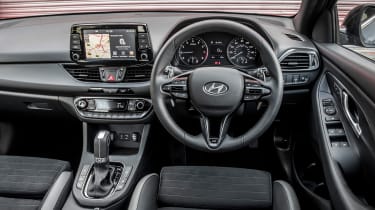New Hyundai i30 N Line review
The new sporty Hyundai i30 N Line has arrived to rival Ford's ST-Line and VW's R-Line alternatives...

The Hyundai i30 N Line is a car aimed at buyers on a budget – whether that’s with regards list price or running costs. The thing is, it isn’t that much cheaper to buy than the immensely capable i30 N. So unless lower insurance premiums are the be-all and end-all, we’d try and stretch to the more powerful car.
The fast and furious Hyundai i30 N has transformed Hyundai from a bit-part family car maker into a serious performance contender. Keen to capitalise on its success, the Korean firm has just launched this: the i30 N Line.
Positioned underneath its flagship sibling, the N Line is a semi-skimmed rival to Ford’s ST-Line cars, VW’s R-Line alternatives, and even BMW’s M Sport line-up. It blends sporty styling with more modest engine options for lower running costs and more affordable insurance premiums.
• Hyundai i30 Fastback vs Mazda 3 Fastback
The i30 is the first Hyundai to get the N Line treatment. There are two trim levels and two gearbox options, linked in every case to a 138bhp 1.4-litre turbo petrol engine. Here, we’re testing the pricier dual-clutch transmission in top-spec N Line+ specification.
Visually, there’s no denying the N Line tweaks give the slightly dowdy-looking i30 a more aggressive personality. All cars get sportier bumpers, twin exhausts and bigger 18-inch wheels; far from a poor-man’s i30 N, it looks every bit the racy hot hatchback.
Used - available now
But despite the aesthetic enhancements, a quick drive in the N Line reveals it’s more Masala than Madras. True, the chassis revisions, updated suspension and superior brakes ensure it handles sweetly, but the engine feels overly restrained next to its beefier brother.
Power delivery is smooth, especially when mated to our car’s DCT box, but there's a lack of urgency on anything other than full throttle. It’s a shame, because the 1.5 TSI unit in a Volkswagen Golf feels genuinely quick in comparison – despite boasting only 10bhp more. We’re yet to try a manual i30 N Line, but we expect this car may feel faster and more involving.
Don’t let this detract from the fact the Hyundai is a genuinely capable and well-resolved family hatchback. The tweaked suspension hasn’t upset the compliant ride, and nor do those big wheels seem to seek out ruts in the road. The steering doesn’t offer much feedback, but it’s far from unpleasant, sending the i30 through tight corners with decent accuracy.
Take things a bit more gently and the i30 N Line is perfectly refined. The engine is hushed around town and settles down nicely on the motorway. We’d have no reservations spending several hours behind the wheel – especially given the sculpted and supportive sports seats.
In fact, the interior is a real highlight; it’s a little dark in the back, perhaps, but all cars are well equipped and Hyundai’s excellent infotainment set-up is one of the most intuitive systems on the market. Perceived quality isn’t far off the i30’s ‘premium’ rivals, either.
N Line+ cars command a £2,000 premium over standard N Line models, but come complete with LED headlights, electric seat adjustment and a heated steering wheel. Sat-nav is a £250 add-on regardless of trim, but we’d avoid that and stick with the capable smartphone-operated Apple or Android mapping systems.
However, those extra costs pale into insignificance when you consider that for just £755 more (£25,010) you can buy yourself a bog-standard i30 N – with 247bhp and almost 400Nm of torque. Granted, the cost difference is bigger if you compare apples with apples; the manual N Line+ is £1,000 less than the pricier auto tested here.
Wring the N Line’s engine out like we did and you’ll find fuel economy doesn’t differ too wildly from the hot hatch, either. Hyundai says our car should return almost 50mpg (compared to the N’s 40.4mpg), but a figure in the high-30s is more likely in day-to-day driving.













